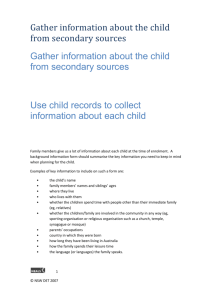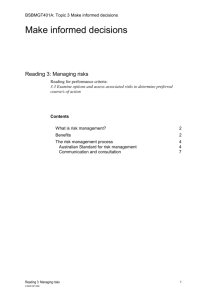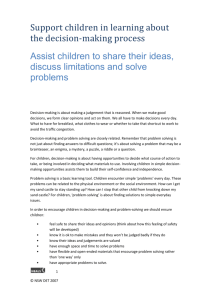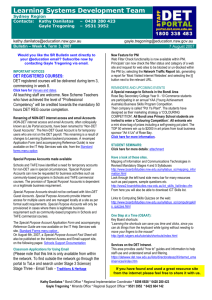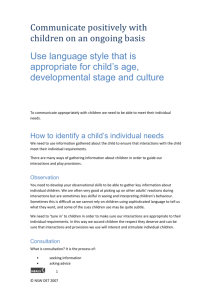Here are the Readings for Exchange information with family
advertisement
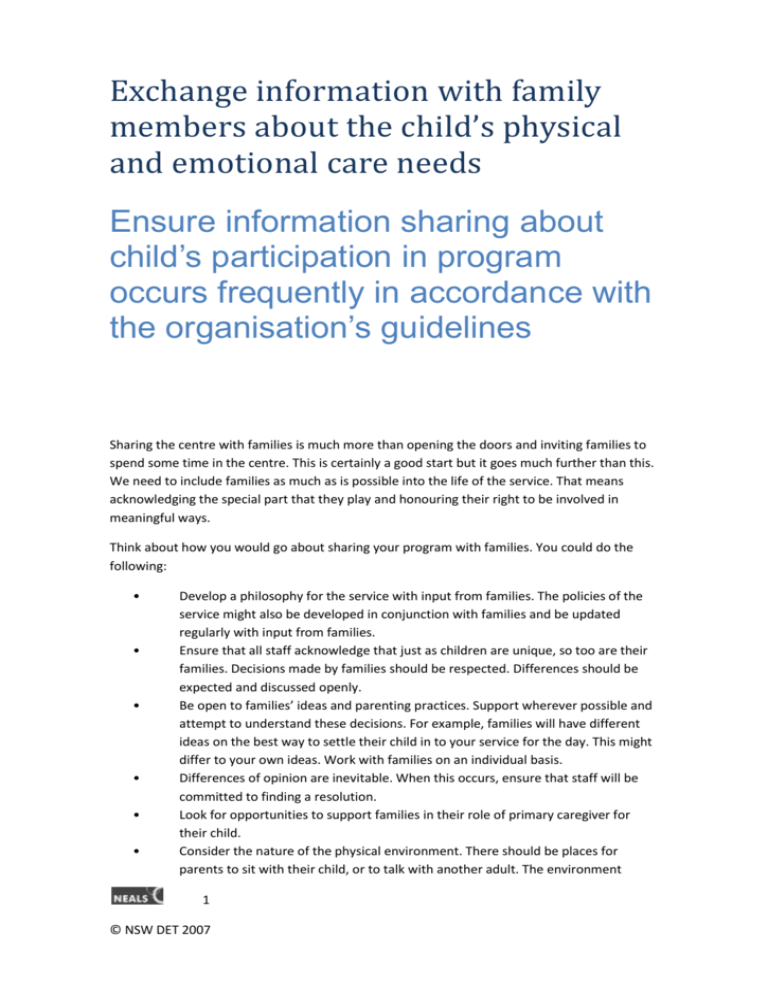
Exchange information with family members about the child’s physical and emotional care needs Ensure information sharing about child’s participation in program occurs frequently in accordance with the organisation’s guidelines Sharing the centre with families is much more than opening the doors and inviting families to spend some time in the centre. This is certainly a good start but it goes much further than this. We need to include families as much as is possible into the life of the service. That means acknowledging the special part that they play and honouring their right to be involved in meaningful ways. Think about how you would go about sharing your program with families. You could do the following: • • • • • • Develop a philosophy for the service with input from families. The policies of the service might also be developed in conjunction with families and be updated regularly with input from families. Ensure that all staff acknowledge that just as children are unique, so too are their families. Decisions made by families should be respected. Differences should be expected and discussed openly. Be open to families’ ideas and parenting practices. Support wherever possible and attempt to understand these decisions. For example, families will have different ideas on the best way to settle their child in to your service for the day. This might differ to your own ideas. Work with families on an individual basis. Differences of opinion are inevitable. When this occurs, ensure that staff will be committed to finding a resolution. Look for opportunities to support families in their role of primary caregiver for their child. Consider the nature of the physical environment. There should be places for parents to sit with their child, or to talk with another adult. The environment 1 © NSW DET 2007 should allow families to feel welcomed rather than looking for a quick route out of the door. Provide opportunities for families to engage in genuine decision making at the service. This could be through involvement in management committees, advisory committees. Look for meaningful ways that families could share in their children’s experiences—perhaps by sharing their own skills with the service and the children. Ensure that information-sharing with families acknowledges that families will have different needs. Consider the family member who does not share in dropping off or collection times, the family where members are unable to read, and families where English is not the home language. Focus on positive information wherever possible. Be honest. Most importantly, share the commitment to ongoing communication with families. • • • • • • Activity 1 Daily information sharing Knowing how much information and what types of information to share with families are difficult. The truth of the matter is that all families are different. Accordingly their expectations and needs will be different in respect of information. Some families will be happy with a monthly newsletter; others will want to know quite detailed information on what their child has been doing throughout the day. It is as individual as each parent. The way we address this question is through our listening skills. As we communicate with families, we need to be attuned to what they are saying and, quite possibly, what their body language is saying to support or contradict their words. We may feel that we have provided enough information for the families and have described in some detail what their child has been doing—but have we really? Perhaps what we have said is like listening to a sound engineer talking about his new speaker system that he has just completed. ‘I have just successfully installed a powered sub woofer into a surround sound home theatre system to capture the normally weak bass response. The 12 inch, 350 watt driver is powered by a dedicated 100 watt amplifier and controlled by a sub base processor that allows optimisation of the both the crossover and roll off frequencies. The driver/box is tuned to a rumbling 30 Hz with a roll off of 150 Hz. The driver is protected from the sub bass frequencies by a cut off circuit that filters out frequencies below 20 Hz. At maximum power it can deliver a 100 Hz signal at 100db, more than enough to satisfy the diehard bass fanatics’. For a family new to the world of children’s services the following message, while quite informative from our point of view, might be just as useful as the message you have just read about the speaker system. 2 © NSW DET 2007 Dear families, What a busy day we have had. We enjoyed playing with goop, building with brio and exploring the jungle on a bear hunt. The children will certainly enjoy sharing their adventures with you today, don’t forget to ask about punchinello! The intention of sharing information is certainly great but the information is written for someone who understands what goop, brio, bear hunts and punchinello are all about. Unless you have witnessed this first hand, it is difficult to imagine the experience let alone relive it through the eyes of an excited toddler with limited language skills. The enrolment interview is often used as one method to gain an understanding of families’ expectation in terms of the care of their child. Understanding these expectations is an important facet of our job. In order to work in partnership with families, we need to get a sense of each family’s goals for their child by asking these very important questions we are communicating that we value their beliefs. Make yourself available for parents to provide information How much information and what type of information do we need to support the children in our care? Really we need as much as possible about children’s needs, routines, preferences and interests if we are to offer the kind of consistency and continuity that children so desperately need. That is not to say that we should set up a video camera in each family’s home a month before they enter our service. That may be a little too much information—let alone being invasive! Child rearing practices are a deeply personal type of caregiving. We cannot replicate them in the absolute but what we can do is to try and model a type of care that the young child will feel comfortable with. Imagine if we were to care for babies strictly based on child development information. We would see the baby only in terms of moving through stages of development and not as a whole human being capable of giving to their environment. We might expect to see differences in child rearing practices amongst different cultural groups. Most importantly we expect to see differences in these practices amongst individuals.’ Activity 2 3 © NSW DET 2007 Family concerns All families will naturally worry about their child. They will worry more when they are not physically with their child. As you made your list in the last activity did you consider some of the worries that families may have? Each family will have their own ways of doing things. Even very simple day-to-day activities will be done differently. We need to work through these variations with families in a way that reassures families that we will be able to provide for their child’s needs. Did your list act as a way of reassuring families that you too had considered these issues and that together you can both ensure that concerns would be addressed? Think for a moment about the types of concerns that families bring with them as they drop their child off at your service. Families will worry about: • • • • • • safety and supervision of children warmth, sleep and the eating needs of children leaving their child in care (they may feel guilty about this) the adequacy of their own caregiving (this may be further exasperated by stresses at work and home) feeling threatened (they may feel that you will become the most important person in their child’s life) feeling incompetent by being given unsolicited advice. Communicate information in a culturally appropriate way We are all unique—that is what makes us special. We do not expect everyone to think in the same way we do; nor do we expect that everyone will necessarily agree with our opinions. We are all unique individuals. Having said that, it can still be difficult to accept when someone disagrees with our ideas. The experiences that we have had, our own upbringing and the beliefs we hold help to shape us. These experiences, upbringing and beliefs vary enormously from person to person. Finding common ground when we are from such different backgrounds should not be difficult; after all we all want the same thing—what is best for the child. 4 © NSW DET 2007 The title of this part of the topic may be a little misleading. When you read the title ‘Communicating information in a culturally appropriate way’, what came to mind? Did you automatically think about families from a country that is different to your own? Did you expect to be dealing with issues related to customs and traditions from another country? This is quite often the assumption that people make when they read this heading. The fact is ‘culture’ is a very complex notion. The NSW Curriculum Framework (OCC, 2002) offers us this definition: Culture: A dynamic, evolving complex collection of values, history, tradition, ways of living, and their material manifestations. Culture is inextricably intertwined with individual and family lifestyles, preferences and tastes. It cannot be defined or captured merely through tangible symbols. Office of Child Care, (2002, p.157) Every family will have their own sense of culture and what is important to them and what is not. Their beliefs, ideals and aspirations will affect the decisions they make and the choices they follow. It is the same for us as carers. Our ideas about what is appropriate and right are greatly influenced by our own values. It is to be expected that from time to time we will be faced with values which conflict with our own. In these cases, it is important to consider why it is we feel the way that we do rather than jump to a decision which we may not be able to justify in the long run. Examples of different cultures Lisa and Susan are both young mothers of Anglo-Australian background who grew up in the same area. Yet the child rearing practices and beliefs of these two mothers are very different. Lisa believes in strong physical discipline from an early age and gave her babies a slap on the hand whenever they were ’naughty’. She bottle fed them all from birth and used controlled crying at three months to train them to sleep through the night in their own room. She introduced solids at four months as she believed it would help them to sleep more soundly. Susan breast fed her babies for as long as possible and had them sleep in her room until they were able to sleep through the night. She believes in ‘constant contact’ whenever possible so she carried her babies in a pouch or held them frequently when they were awake. She tried to speak gently and quietly to her children and distracted or redirected babies when she felt they were in danger or bothering someone else. Lisa and Susan will probably come to a childcare centre with different expectations about what makes quality care for children, and their children may have different needs at routine times due to their home experiences. When problems arise due to differences in cultural expectations, it is time to listen rather than react. It is easy to assume you know why a person has made the decision they have. It is a lot more difficult to sit back and listen with an open mind. If we are to appreciate each person’s uniqueness, listen we must. 5 © NSW DET 2007 Modifying practices There will be times when reaching agreement between carers and parents about children’s care will not be straight forward. Perhaps you have experienced this first hand. A climate where these issues are freely discussed and negotiated will assist in resolving these issues. We might approach such a situation in the following way: • • • • • • • • Firstly acknowledge the families feelings; show empathy as the situation and reasons are explained. Be prepared to discuss the reasons behind our own practices. Reflect on these reasons in order to truly understand their rationale. Avoid the use of judgmental comments or put-downs. Be willing to approach this situation with an open mind. Be careful that you have not already jumped to a conclusion about the basis for the family’s beliefs. Listen to comments made and accept these without necessarily agreeing with them. We need to be respectful of decisions made by families—not just tolerate differences. Clarify your understanding of the problem. Ask the parent to continue discussing the issue and working on solutions together. Continue the problem solving by brainstorming possibilities. It is reasonable to assume that we may not find a workable solution straight away; it may take some time. Remember to emphasise the collaborative nature of the process—that is, a process where everyone contributes their ideas towards the final decision. Communicating information appropriately Think of times when you had to communicate information to people that you did not know well (eg, people you met for the first time). Think of people of a different age group or of a different cultural and linguistic background to yours. Did you make assumptions about these individuals—based on their appearance? Assumptions We change the way we communicate when we are dealing with a toddler and then with a school aged child. This is appropriate. We make assumptions based on the child’s developmental level and experiences. Making assumptions based on families’ appearance is not appropriate. When we communicate with families we need to be careful that we are not using an assumption based on their culture, age or linguistic background as a characteristic in the way we deal with them. Such assumptions can prove dangerous in the establishment of a partnership with families. 6 © NSW DET 2007 Open communication is the foundation of any relationship. It is only through openly exploring differences that we can ascertain if differences actually exist. As families have experiences within the centre environment and outside of it, their own decisions and priorities for their child will change. We might say that they are living their culture and as such modifications might result. Ongoing communication is then paramount in continuing to provide for this child and this family. Imagine that you have met someone for the first time at a party or gathering. Which of your values, beliefs and family traditions will you be willing to share in the first few minutes of this conversation? Sounds a little confronting doesn’t it? While we recognise that knowing as much as we can about families and their culture is important we also need to recognise that culture is extremely personal. We may not be ready to share our life history with a stranger at an enrolment interview. Such information is usually shared with people we trust and whom we feel won’t judge us based on this information. Finding out about a families culture will then take time, trust and respect. Building in time during the day to meet with families on an informal basis will provide us the opportunity to blend questions into daily conversation. Families will need to feel that differences or diversity is welcomed and accommodated for in your setting. Activity 3 Respond to messages promptly Have you ever left a message on someone’s answering machine and then not have your message responded to? You are left wondering if the person got your message at all. Had they heard the message and misunderstood it or were they simply not interested enough to call back? It is frustrating, isn’t it? Especially when you are seeking information or you have important information to pass on. After a while, this frustration may turn to anger, concern or even hostility. It is no different for families when they arrive in the morning with an important message to pass on to their child’s primary caregiver. They rely on someone to pass this information on promptly and with the same degree of importance as they communicated when they gave you the message. Sometimes the message may seem trivial or unimportant but it is most definitely not to that family. They are providing you with information that they feel is important for you to know to properly care for their child that day. We have said it time and time again. It is a busy place. It is difficult to stop in the middle of a finger painting experience to discuss a child’s day (particularly when sensitive news needs to be shared). It is even more difficult when you are the only carer at the service such as in Family Day Care. Regardless of the difficulty it still needs to be done. 7 © NSW DET 2007 Parents need and have a right to information. A partnership demands that we find a way to share information. The question then is: How do we make ourselves available to families, as they require? Activity 4 Ensuring messages are dealt with A lack of attention to messages communicates to the family that this message is not important or that you are not important. This is the kind of message that will tear away at a relationship that you are attempting to establish with this family. It also says a lot about our own credibility and professionalism. If we are not concerned about acting in a professional manner in the way that we deal with families, then how can we be trusted to care for their children? The fact is we are busy. Sometimes messages will take a little longer than we have time to respond to. It only takes a moment, however, to ring someone and acknowledge their message with a promise to call back at a quieter time of the day. This is courteous and, above all, professional. Regardless of whether we are working in a Childcare Centre, a Pre-school, a Family Day Care home or an Out of School Hours setting, we all have competing demands to meet. The systems that we put in place to assist us in meeting these demands are most important. When we consider, for example, a childcare centre with its long day and staff shifts we add yet another complication. Activity 5 8 © NSW DET 2007

